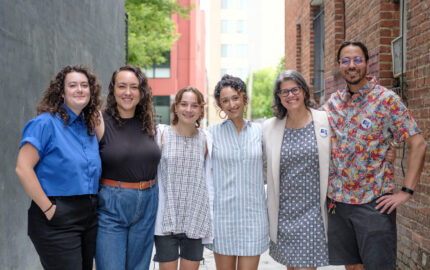Residents of Reston, Virginia take pride in living in one of the nation’s first and oldest planned suburban communities. But it galls some of them that Reston, as part of Fairfax County, doesn’t have its own local government. So there’s been a long-running community debate about seceding from the county and setting up Reston as an independent town.
If you don’t live in Reston, this is a fairly esoteric and mundane topic. At Backfence, the network of hyperlocal citizen journalism Web sites we launched a couple of years ago, we’d roll our eyes a bit whenever one of our Reston members posted a story about the “town status” idea. “There they go again,” we’d think. But we also knew that we were in for a vigorous online discussion, with a great deal of audience participation and readership, as Reston residents passionately argued for and against secession on Backfence’s pages.
Participatory community news sites like Backfence and others started by entrepreneurs and traditional media companies are providing a forum for local residents to share their knowledge and opinions about local life. These “hyperlocal” community discussions represent a new sort of journalism and storytelling—what some have labeled “citizen journalism.” Don’t expect the traditional “who/what/where/when” or inverted pyramid formats. Instead, these discussions produce back-and-forth exchanges of hundreds of words of passionate prose, written by residents, which provide far more detail and nuance on a topic than a traditional news story ever could. They also provide a depth of coverage of microscopic issues and events that thinly stretched traditional newsrooms simply can’t get to.
As hyperlocal citizen journalism sites have sprung up around the country, some journalists have viewed them with consternation. Are these substitutes for traditional professional reporting? No, they aren’t. Do they hew to the spirit of impartiality that journalists strive for? No, they don’t. But they do provide an additional, complementary forum for the airing of local issues.
Community Voices
Backfence proved a fascinating laboratory for this new form of journalism in its two-plus years of operation, before closing earlier this year for business reasons. Similar hyperlocal sites such as iBrattleboro.com, WestportNow.com, and Baristanet.com are carrying on similar pioneering work. While there are varying approaches on all of these sites, each provides local citizens a voice in their communities and a new source of local information at a microscopic level that traditional media simply can’t match.
At Backfence, we saw countless examples of community members sharing their knowledge of the local scene with each other. A local Little League team’s run to the national championship was covered in real time, through stories and photos posted by the league commissioner days before similar news appeared in local papers. When Virginia officials proposed privatizing a toll road, a Backfence contributor posted a detailed analysis of the potential fiscal impact; this kind of in-depth “reporting” was unavailable anywhere else. A group of citizens united to try to save an architecturally significant building after learning on Backfence that it was going to be torn down. Backfence users lamented the closing of a popular store. Contributors reviewed restaurants, electricians and beauty salons. Local government officials used the sites to communicate directly with their constituents.
This isn’t Woodward and Bernstein stuff, of course, and the citizen journalism practiced on Backfence and other user-contributed sites bears only passing resemblance to traditional journalism. Participants generally don’t act as reporters; they write what they know. It’s the ensuing discussions with other contributors that can produce a well-rounded report. The quality of the writing would make a journalism professor or copyeditor blanch, but what gets conveyed is nonetheless quite understandable in most cases—and often much better than many professionals would expect. And in spite of the seeming free-for-all nature of user-generated content (which always seems to scare journalists), we had very few problems with abuse of the sites.
The citizen journalism movement, which also includes hundreds of local blogs focusing on community issues and politics, still is in its nascent stages; none of these sites is more than three or four years old. But many of them have become important forces in their communities—and are beginning to find their footings as viable businesses, as local advertisers flock to them as a way to reach the customers closest to them at affordable prices. Over the next few years, I believe, as the digital hyperlocal format matures, local I.F. Stone-like journalists will emerge, doing more sophisticated local reporting and publishing themselves through blogs or community sites.
Citizen journalism also is presenting an opportunity for traditional media to extend its reach deeper into local communities. Many newspapers and broadcasters are beginning to experiment with their own locally oriented, user-contributed sites, discovering that they provide a low-cost way to provide detailed coverage of issues and stories too inconsequential to assign to a staff reporter or to gather firsthand accounts, photos and videos. Newspapers also are beginning to draw on this force of amateur contributors to help out with broader, staff-directed investigative stories, in a phenomenon known as crowdsourcing.
In perhaps the best example of this, The (Fort Myers) News-Press, a Gannett-owned paper in Florida, enlisted the help of dozens of community members—experts and regular citizens—to investigate the high cost of local sewer service. In all, some 110 stories about this issue were generated, leading to a 30 percent reduction in fees and a local official’s resignation. And the “microsite” that hosted discussion about this topic became the most visited part of the News-Press Web site.
Journalism and Hyperlocal
As professional journalists interact with their citizen counterparts, there are a few things worth keeping in mind:
- It’s not journalism, it’s a conversation. Don’t expect participants to do reporting, at least not in the classic sense. The magic of user-generated sites is that they provide a forum for community members to share and discuss what’s going on around town. An active online conversation can be as rich, deep and interesting—or more so—than traditional journalism.
- Trust the audience. There seems to be fear among many journalists that opening up their Web sites to audience participation will lead to trash talking. That’s a risk, but there are many safeguards that can be put in place—profanity filters, forum moderation, “report abuse” mechanisms—to minimize this. At Backfence, the audience took responsibility for what went on at each site and debated local issues in a civil manner because it was about their community.
- It’s a window into a community. What people really care about and what editors and reporters think they care about can be very different things. Citizen journalism sites can be rich sources for journalists of information about what’s important to local residents. We lost count of how many stories originated from community members on Backfence and showed up a few days later in the local newspapers.
- People will write about their local community for free. This flummoxes many journalists, who assume that no one will create content without being paid. But citizen journalists get different kinds of rewards—the sense that they’re “experts” in their community, a chance to have their voices heard—that make them happy to share what they know without expecting compensation.
- An important role still exists for traditional journalism. I can’t stress this enough: Citizen journalism doesn’t replace old-fashioned shoe-leather professional journalism. It augments and extends it by providing new ways to cover news that journalists can’t get to and by giving “audience” members a voice.
For a print or broadcast entity that wants to defend and enhance its local franchise, citizen journalism is an important tool. It broadens coverage and gives the community a highly personalized stake in local media. By providing an inexpensive means to cover the mundane to-and-fro of daily life, it frees up professional journalists to dig deeper into local stories. Most importantly, it provides a vehicle for the audience to find out what’s happening up the street, not just around the world. Hyperlocal citizen journalism, literally, engages people where they live.
Mark Potts, a former journalist, is an entrepreneur and consultant who cofounded washingtonpost.com and Backfence Inc., a pioneer in the field of user-generated, hyperlocal citizens media. He blogs about the intersection of media and the online world at www.recoveringjournalist.com.



